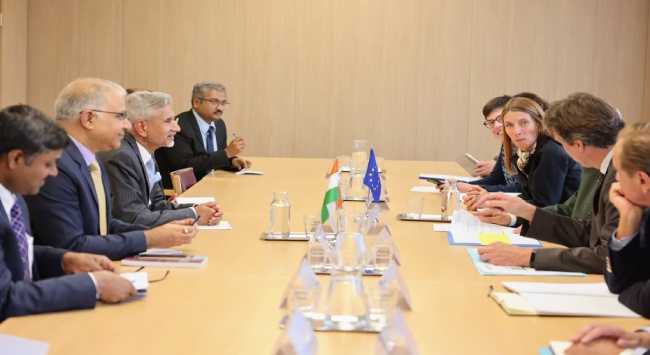Summary
The time has come for the European Union-India Trade and Technology Council to emphasise practical cooperation.
In April 2023, the EU-India Trade and Technology Council (TTC) was launched with considerable interest. Both parties had several reasons to boost their cooperation on technology and trade issues. Yet, progress or the pathway to progress has not been adequately set. It is now time for both partners to set the agenda rolling on strategic cooperation as technologies become sharply implicated in major power strategic competition and how countries craft economic policies to protect themselves from the effects of conflict and constraint.
At the 2023 TTC launch, European Commission President Ursula von der Leyen lauded the new initiative, calling the future of a relationship that has not ‘reached its full potential’. For the European Union (EU), this technology partnership follows other such initiatives with the United States (US), Japan, Singapore and South Korea to help address and coordinate key technology matters with the hope of producing a more open and transparent global digital environment. These partnerships further build on existing initiatives that the EU has developed in Africa (EU-Africa Joint Vision for 2030) and Latin America (EU-Latin America and Caribbean Digital Alliance). The focus and intent are to work with ‘like-minded partners’ to advance the development of technologies that are reliable, accessible and trustworthy. India is in a similar mindset. New Delhi and Washington launched the US-India Initiative on Critical and Emerging Technology to push forward technology links between both countries.
Amongst these initiatives, the EU-India stands out, given its genesis and driving motivations. The partnership was driven less by digital interests, given modest technological engagement between both parties. Instead, the TTC was necessitated by broader strategic logics, notably the need for the EU and India to expand diplomatic space in a context marked by US-China competition. Both the EU and India prefer a multipolar world and see their partnership as working toward that outcome. New Delhi emphasises strategic autonomy and investing in partnerships that widen its options, and several European countries are also keen to expand their focus and space. Both partners would like to lessen their dependence on China and Russia and are troubled by the Sino-Russian alignment. Shared concerns over China’s threat to the global economy provide another critical motivation for joint cooperation. New Delhi continues to run a large trade deficit with Beijing that requires lessening, and both the EU and India remain dependent on Chinese imports and inputs for their exports.
Yet, these strategic logics are necessary but insufficient to propel cooperation through the TTC’s three working groups that focus on digital governance and connectivity, green and clean energy technologies, and supply chain resilience. Normative differences in core technology could be constraining practical cooperation. For instance, the EU prefers and prioritises user rights, while in India, the state dominates digital conversations, especially those involving data protection and flows. How do both partners increase digital interoperability when disagreements exist over how data is stored and processed? Discord lingers on trade issues, related to market access and tariffs on electronic goods. India has expressed deep misgivings over the EU’s Common Border Adjustment Mechanism that taxes goods not produced in a sustainable manner. That said, it is difficult to redress these core normative preferences without some joint technology projects.
Another constraint with the EU-India TTC has to do with expanding its remit beyond just governments but with other stakeholders, especially the private sector. There are no imminent efforts to design public-private partnerships between both partners on issues like semiconductors, green hydrogen, solar panels, batteries for electric vehicles, cybersecurity, quantum computing and artificial intelligence. These conversations need to be facilitated to trigger projects that could potentially scale up. Signals alone are insufficient. Given the pace and scale of innovation occurring in Europe and India, the TTC should create spaces or vehicles that allow firms to discuss and pool their expertise for new projects. Such projects could then flow back to officials, helping bridge the differences in regulating critical and emerging technologies.
The expectations from the Indian side with respect to this TTC are generally modest. So far, the EU-India TTC has not been placed on a path to deliver on its objectives. Both parties have to use and deploy the broader strategic convergence to deepen cooperation on trade and technology issues. There is a deep and growing economic partnership between the EU and India. There appears to be demand and opportunities for both parties, given size and scale, to collaborate and cooperate in areas that are strategic and of long-term importance, especially if there are shocks to the system and if China and Russia get closer. The EU’s capabilities in areas like defence, space and cybersecurity offer immense potential for India and vice-versa, given India’s ongoing technological trajectory. Yet, unless efforts are made to broaden the TTC’s ambit that could hopefully bridge core normative and institutional differences, the promise and potentials of the TTC will remain promise and potentials, not progress.
. . . . .
Dr Karthik Nachiappan is Research Fellow at the Institute of South Asian Studies (ISAS), an autonomous research institute at the National University of Singapore (NUS). He can be contacted at isaskn@nus.edu.sg. The author bears full responsibility for the facts cited and opinions expressed in this paper.
Pic credit- Twitter
-
 More From :
More From :
-
 Tags :
Tags :
-
 Download PDF
Download PDF


